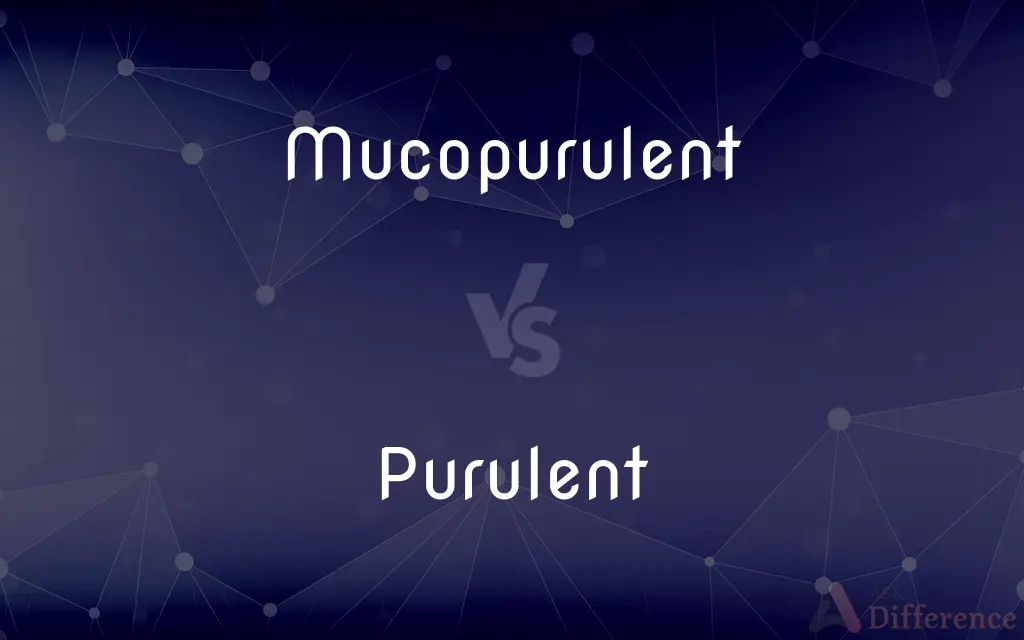Mucopurulent vs. Purulent — What's the Difference?
Edited by Tayyaba Rehman — By Fiza Rafique — Updated on November 6, 2023
Mucopurulent discharge contains mucus and pus, suggesting inflammation with infection. Purulent refers to discharge composed mostly of pus, indicating a bacterial infection.

Difference Between Mucopurulent and Purulent
Table of Contents
ADVERTISEMENT
Key Differences
Mucopurulent is an adjective used to describe a type of bodily discharge that contains both mucus and pus. This kind of discharge typically signifies an infection that may be bacterial or viral in nature, combined with inflammatory responses. The presence of mucus, which is a slippery secretion, indicates that the body’s mucous membranes are involved and are reacting to the infection.
Purulent, on the other hand, specifically describes a discharge that is full of pus, which is a thick, opaque liquid composed of white blood cells, dead tissue, and bacteria. It is generally associated with a bacterial infection where the body's immune system is actively fighting off the invading pathogens. Purulent discharges are often yellowish or greenish and can be a sign of a more localized bacterial infection.
In terms of appearance, mucopurulent discharge is typically less thick than purulent discharge due to the presence of mucus. It can be seen in conditions such as bronchitis or certain sexually transmitted infections where inflammation is present along with infection. Mucopurulent discharges can be a sign of chronic diseases, where there's an ongoing irritation to the mucous membranes.
Purulent discharges are indicative of acute bacterial infections like abscesses or boils. The absence of mucus means that the discharge is primarily composed of the byproducts of the immune response. It often indicates a more serious infection where the body is producing a large number of white blood cells to fend off the infection.
While both terms describe the presence of infection and immune response, mucopurulent suggests a combination of mucus production and pus, which may be less specific in identifying the type of infection. Purulent is more specifically associated with bacterial infections and is commonly used to describe the nature of discharge in conditions like impetigo or infected wounds.
ADVERTISEMENT
Comparison Chart
Composition
Contains mucus and pus
Contains mostly pus
Indication
Suggests inflammation and infection
Indicates bacterial infection
Consistency
Less thick, slippery
Thick, often opaque
Common Associations
Bronchitis, some STDs
Abscesses, boils
Color
Yellowish-green, may be less intense
Often bright yellow or green
Compare with Definitions
Mucopurulent
Describing secretions from a site of infection that is both slimy and filled with pus.
A mucopurulent discharge was noted in the patient's infected eye.
Purulent
Relating to or containing pus, especially as a symptom of infection.
The purulent drainage from the wound signaled a possible infection.
Mucopurulent
Characteristic of fluids produced by inflamed tissues combining mucus and pus.
The bronchial secretions were mucopurulent, indicating a respiratory infection.
Purulent
Descriptive of exudates rich in white blood cells, bacteria, and cellular debris.
The cut became swollen and started oozing purulent fluid.
Mucopurulent
Indicative of an emission comprising both mucus and pus.
The patient's mucopurulent nasal discharge suggested a possible sinus infection.
Purulent
Indicative of a secretion or fluid filled with pus due to bacterial invasion.
He was prescribed antibiotics for his purulent skin lesions.
Mucopurulent
Referring to the dual presence of mucus and infectious pus in exudate.
The wound was oozing a mucopurulent fluid, necessitating medical attention.
Purulent
Pertaining to an abscess or other infected tissue areas producing pus.
The purulent abscess required immediate draining.
Mucopurulent
Pertaining to a mix of mucus and purulent material in pathological discharges.
The doctor diagnosed the mucopurulent expectoration as a symptom of chronic bronchitis.
Purulent
Denoting a thick, often yellowish or greenish, pus-filled discharge from an infection.
A purulent discharge was noted during the examination of the infected ear.
Mucopurulent
Consisting of mucus and pus.
Purulent
Consisting of, containing, or discharging pus
A purulent discharge
Mucopurulent
Containing mucus and pus.
Purulent
Containing, discharging, or causing the production of pus
A purulent infection.
Mucopurulent
(medicine) Characterized by mucus and pus.
A mucopurulent discharge
Purulent
(medicine) Consisting of pus.
Mucopurulent
Having the character or appearance of both mucus and pus.
Purulent
Leaking or seeping pus.
Purulent inflammation
Mucopurulent
Containing or composed of mucus and pus
Purulent
Consisting of pus, or matter; partaking of the nature of pus; attended with suppuration; as, purulent inflammation.
Purulent
Having undergone infection;
A purulent wound
Common Curiosities
Can mucopurulent discharge be clear?
Mucopurulent discharge is usually not clear, as it contains pus; it's typically yellowish-green.
Can mucopurulent discharge come from the eye?
Yes, conditions like conjunctivitis can cause mucopurulent discharge from the eye.
Is purulent discharge always a sign of infection?
Yes, purulent discharge is a sign of infection, particularly bacterial.
Can mucopurulent discharge be chronic?
Yes, it can be chronic in conditions like bronchitis or certain STDs.
What does purulent mean?
Purulent describes a discharge composed predominantly of pus, typically associated with a bacterial infection.
What does mucopurulent mean?
Mucopurulent refers to a discharge that contains both mucus and pus, indicating an infection with inflammation.
Are there home remedies for mucopurulent conditions?
Home remedies may provide relief, but medical treatment is often necessary.
What is the treatment for mucopurulent conditions?
Treatment may include antibiotics or antivirals, depending on the underlying cause.
What color is purulent discharge?
Purulent discharge is often yellow, green, or brown.
Can purulent discharge have a smell?
Yes, it can have a foul odor due to the presence of bacteria and dead tissue.
Are mucopurulent and purulent discharges contagious?
Both can be contagious if caused by infectious agents like bacteria or viruses.
How is purulent discharge treated?
Treatment typically involves antibiotics to target bacterial infections.
Is mucopurulent discharge a sign of a STD?
It can be, as some STDs cause mucopurulent discharge.
Should I cover a wound with purulent discharge?
Yes, to prevent contamination and spread of infection, but seek medical advice.
Can mucopurulent discharge be prevented?
Good hygiene and vaccinations can help prevent infections that cause such discharges.
Share Your Discovery

Previous Comparison
Metamorphosize vs. Metamorphose
Next Comparison
Constantly vs. ConsistentlyAuthor Spotlight
Written by
Fiza RafiqueFiza Rafique is a skilled content writer at AskDifference.com, where she meticulously refines and enhances written pieces. Drawing from her vast editorial expertise, Fiza ensures clarity, accuracy, and precision in every article. Passionate about language, she continually seeks to elevate the quality of content for readers worldwide.
Edited by
Tayyaba RehmanTayyaba Rehman is a distinguished writer, currently serving as a primary contributor to askdifference.com. As a researcher in semantics and etymology, Tayyaba's passion for the complexity of languages and their distinctions has found a perfect home on the platform. Tayyaba delves into the intricacies of language, distinguishing between commonly confused words and phrases, thereby providing clarity for readers worldwide.















































